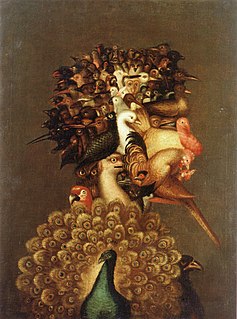 W
WThe Cook is a c.1570 oil on panel painting by Giuseppe Arcimboldo, now in the Nationalmuseum in Stockholm. It is a still life of roasted meats - when the painting is turned upside-down, these form a human face via pareidolia. The painter also produced The Fruit Basket and The Gardener, using a similar effect.
 W
WThe Four Elements is a series of four oil paintings by the Italian artist Giuseppe Arcimboldo which were created in 1566, during the Renaissance, for Maximilian II, Holy Roman Emperor. The paintings depict human faces in profile made up from different animals or objects. Air is represented by birds, Fire by burning wood and cannons, Earth by land animals and Water by marine creatures. The series attempts to express the creation of harmony from chaos by the careful arrangement of the wild animals to form portraits whilst also praising Maximilian by suggesting that he is a ruler who controls even the four primal elements.
 W
WThe Seasons or The Four Seasons is a set of four paintings produced in 1563, 1572 and 1573 by Giuseppe Arcimboldo. He offered the set to Maximilian II, Holy Roman Emperor in 1569, accompanying The Four Elements. Each shows a profile portrait made up of fruit, vegetables and plants relating to the relevant season. The set was accompanied by a poem by Giovanni Battista Fonteo (1546-1580) explaining their allegorical meaning.
 W
WThe Fruit Basket or Reversible Head with a Fruit Basket is a c.1590 oil on panel still life by Giuseppe Arcimboldo, now French and Company in New York. When reversed, it shows an anthropomorphic head. The same painter also produced The Cook and The Gardener.
 W
WThe Gardener, The Vegetable Gardener or Vegetables in a Bowl is a 1587–1590 oil on panel painting by Giuseppe Arcimboldo, now in the Museo Civico Ala Ponzone in Cremona. One way up it shows a bowl of vegetables - the other way up it shows a human face by pareidolia. The face includes several suggestions of the male and female genitalia, meaning that it can be interpreted as Priapus, the ithyphallic pagan god of fertility and protector of gardens. The same painter also produced The Fruit Basket and The Cook.
 W
WThe Jurist, also known as The Lawyer, is an oil-on-canvas painting by Italian artist Giuseppe Arcimboldo, painted in 1566.
 W
WThe Librarian is an oil on canvas painting by Giuseppe Arcimboldo in the collection of Skokloster Castle in Sweden. It is thought to be a portrait of Wolfgang Lazius, a humanist and historian who served Holy Roman Emperors of the House of Habsburg.
 W
WVertumnus is an oil painting produced by Giuseppe Arcimboldo in 1591 that consists of multiple fruits, vegetables and flowers that come together to create a self-portrait of Holy Roman Emperor Rudolf II. Although Arcimboldo's colleagues commented that Vertumnus was scherzo, or humorous, there were intentional political meanings behind the piece, particularly regarding the choice of fruits, vegetables, and flowers. Arcimboldo's choice to include these items was also an intentional reference to the Roman god, Vertumnus.